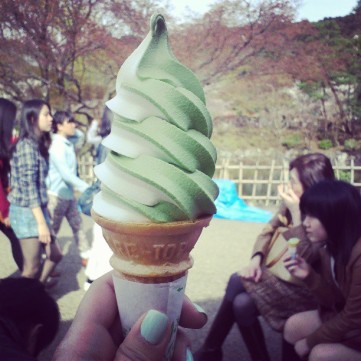 Over my spring break, along with S and CT, I visited the Kansai region, namely to do some sightseeing in two of most popular tourist destinations in Japan: Osaka and Kyoto. Being an art history nerd, I was very excited to visit the various temples that can be found around the region, but we also planned to check out Osaka’s famous Kaiyuukan aquarium, a woodblock print museum, and,of course, the shopping scene in Nanba! I was also personally looking forward to one of my favourite treats, matcha and vanilla swirl soft-serve! While it’s possible to get it in the Kanto region where I live, it’s way more common in Kansai, and since I love anything matcha or Japanese green tea flavored, I was really looking forward to it!
Over my spring break, along with S and CT, I visited the Kansai region, namely to do some sightseeing in two of most popular tourist destinations in Japan: Osaka and Kyoto. Being an art history nerd, I was very excited to visit the various temples that can be found around the region, but we also planned to check out Osaka’s famous Kaiyuukan aquarium, a woodblock print museum, and,of course, the shopping scene in Nanba! I was also personally looking forward to one of my favourite treats, matcha and vanilla swirl soft-serve! While it’s possible to get it in the Kanto region where I live, it’s way more common in Kansai, and since I love anything matcha or Japanese green tea flavored, I was really looking forward to it!
 After spending our first night in Osaka shopping, looking around the area, and taking the chance to sing karaoke together, we headed out the next day to Kyoto to see some historical sites. Our first stop was Kinkakuji, a very famous and popular destination for both Japanese and foreign tourists. Kinkakuji was originally a villa owned by Muromachi period shogun Ashikaga Yoshimitsu, and, after his death, it was converted into a Zen temple, as per his wishes. Architecturally, the building is interesting and complex because its three floors are each designed in a different style: the first floor is in the old Kyoto court style used to create buildings for the aristocracy in the Heian period, the second floor is built in the style of samurai buildings, and the third floor is built in traditional Chinese Chan (or Zen) Buddhist style. The garden around the building also contains plenty of visual interest; it contains various illusions to Japanese literature (a common aesthetic choice in Japanese garden design) and as a whole is based on descriptions of the Western Heaven on Zen Buddhism. Additionally, Kinkakuji is the famous titular temple described in Yukio Mishima’s The Temple of the Golden Pavilion, which is based on real events that took place when a monk burned down the temple in 1950. All in all, Kinkakuji is full of visual and historical interest, and though I had been once before, I was happy to go again!
After spending our first night in Osaka shopping, looking around the area, and taking the chance to sing karaoke together, we headed out the next day to Kyoto to see some historical sites. Our first stop was Kinkakuji, a very famous and popular destination for both Japanese and foreign tourists. Kinkakuji was originally a villa owned by Muromachi period shogun Ashikaga Yoshimitsu, and, after his death, it was converted into a Zen temple, as per his wishes. Architecturally, the building is interesting and complex because its three floors are each designed in a different style: the first floor is in the old Kyoto court style used to create buildings for the aristocracy in the Heian period, the second floor is built in the style of samurai buildings, and the third floor is built in traditional Chinese Chan (or Zen) Buddhist style. The garden around the building also contains plenty of visual interest; it contains various illusions to Japanese literature (a common aesthetic choice in Japanese garden design) and as a whole is based on descriptions of the Western Heaven on Zen Buddhism. Additionally, Kinkakuji is the famous titular temple described in Yukio Mishima’s The Temple of the Golden Pavilion, which is based on real events that took place when a monk burned down the temple in 1950. All in all, Kinkakuji is full of visual and historical interest, and though I had been once before, I was happy to go again!
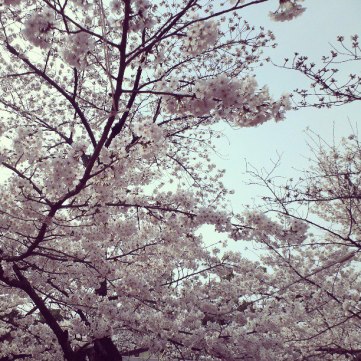 After Kinkakuji, our next stop was Maruyama Park, where we planned to do hanami. While Japanese culture is highly fond of all four seasons and the plants and nature that go along with them, the most celebrate flower of all is the cherry blossom or sakura, which only blooms in Japan for about two weeks. Because the briefness of the beautiful sakura blossoms echoes the impermanence of life as taught by Buddhism, it’s been the subject of many poems and works of art throughout Japanese history, and even today, hanami is a must-do for many people during the sakura season. It’s hard to define hanami in just one word, but it’s comprised of the characters for “look” and “flower,” so I guess “flower-watching” is one way to put it. Typically, doing hanami means going to a park or somewhere with sakura trees in bloom and having a picnic or meal, drinking alcohol, and talking with friends, all the while admiring and enjoying the scenery of cherry blossoms. Since Kyoto is a scenic and picturesque place, it seemed like a great choice for hanami, and luckily for us, the weather was perfect, and our timing was just right to catch the cherry blossoms in full bloom!
After Kinkakuji, our next stop was Maruyama Park, where we planned to do hanami. While Japanese culture is highly fond of all four seasons and the plants and nature that go along with them, the most celebrate flower of all is the cherry blossom or sakura, which only blooms in Japan for about two weeks. Because the briefness of the beautiful sakura blossoms echoes the impermanence of life as taught by Buddhism, it’s been the subject of many poems and works of art throughout Japanese history, and even today, hanami is a must-do for many people during the sakura season. It’s hard to define hanami in just one word, but it’s comprised of the characters for “look” and “flower,” so I guess “flower-watching” is one way to put it. Typically, doing hanami means going to a park or somewhere with sakura trees in bloom and having a picnic or meal, drinking alcohol, and talking with friends, all the while admiring and enjoying the scenery of cherry blossoms. Since Kyoto is a scenic and picturesque place, it seemed like a great choice for hanami, and luckily for us, the weather was perfect, and our timing was just right to catch the cherry blossoms in full bloom!
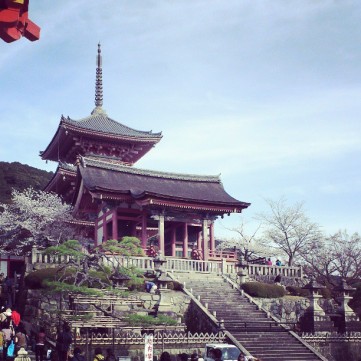 After our hanami, we headed to our next temple destination: Kiyomizudera! Kiyomizudera is a temple comissioned by Tokugawa Iemitsu, one of the important political figures of the Edo period in Japanse history (the period famous for isolationism, samurai, and kabuki). It is set into a steep hill in Kyoto, and thus is a very popular tourist destination for its great views… however, this also makes it a pain to get to because you have to walk so far uphill! But it’s well worth it, and seeing it surrounded by cherry blossoms was quite the sight, even if the place was packed with tourist. Actually, some of the Japanese tourists provided an interesting addition to the temple itself; while I’ve never seen this in Tokyo or Gunma or anywhere else in Japan, there were many Japanese (and some Chinese, actually) tourists dressed in traditional Japanese kimono, and I enjoyed admiring them as well as the scenery.
After our hanami, we headed to our next temple destination: Kiyomizudera! Kiyomizudera is a temple comissioned by Tokugawa Iemitsu, one of the important political figures of the Edo period in Japanse history (the period famous for isolationism, samurai, and kabuki). It is set into a steep hill in Kyoto, and thus is a very popular tourist destination for its great views… however, this also makes it a pain to get to because you have to walk so far uphill! But it’s well worth it, and seeing it surrounded by cherry blossoms was quite the sight, even if the place was packed with tourist. Actually, some of the Japanese tourists provided an interesting addition to the temple itself; while I’ve never seen this in Tokyo or Gunma or anywhere else in Japan, there were many Japanese (and some Chinese, actually) tourists dressed in traditional Japanese kimono, and I enjoyed admiring them as well as the scenery.
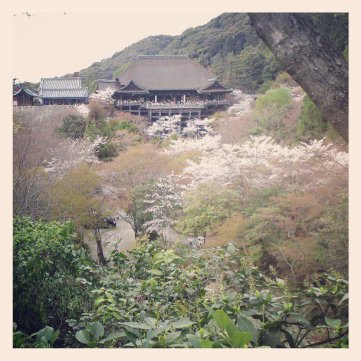 Walking around Kiyomizudera is quite the undertaking because the path leads around the side of the mountain and back again, but it really does give a beautiful view of the temple and its surroundings, as well as of the city of Kyoto on the horizon. Especially with all of the sakura in full bloom, I was happy to get a chance to see the sights. There are a lot of sub-buildings (and even an entire separate temple sort of off to the side) around the grounds, as well, so I was happy for the opportunity to get to check them all out!
Walking around Kiyomizudera is quite the undertaking because the path leads around the side of the mountain and back again, but it really does give a beautiful view of the temple and its surroundings, as well as of the city of Kyoto on the horizon. Especially with all of the sakura in full bloom, I was happy to get a chance to see the sights. There are a lot of sub-buildings (and even an entire separate temple sort of off to the side) around the grounds, as well, so I was happy for the opportunity to get to check them all out!
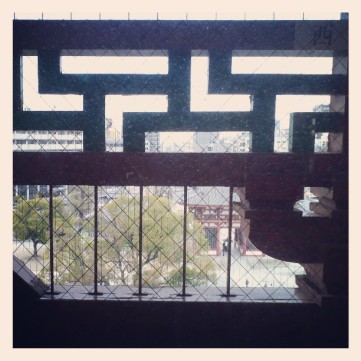 After Kiyomizudera, we headed back to Osaka for the night, and then, the next morning, we headed out to the Kaiyukan Aquarium! While it’s nothing that special, it’s a large aquarium with lots of different species and even some aquatic-related mammals, like the recently-popular capybara! After the aquarium, we headed to Shitennouji temple, for which I was quite excited! One reason, embarrassingly, is that one of the schools featured in the popular manga and anime series Prince of Tennis is based off of Shitennouji, or, to be exact, the attached middle school there. But mostly, I was excited to see their five-story pagoda! Many Buddhist temples in Japan have five-story pagodas, but the special feature of Shitennouji’s is that tourists are allowed to ascend to the top! Most temples only allow tourists in on the entry level or not at all, and so I was excited to go inside. While what was inside was actually not that interesting (the interior had obviously been redone since it was build, with linoleum floors and all), the view from the top, as well as the basic architectural elements were really beautiful!
After Kiyomizudera, we headed back to Osaka for the night, and then, the next morning, we headed out to the Kaiyukan Aquarium! While it’s nothing that special, it’s a large aquarium with lots of different species and even some aquatic-related mammals, like the recently-popular capybara! After the aquarium, we headed to Shitennouji temple, for which I was quite excited! One reason, embarrassingly, is that one of the schools featured in the popular manga and anime series Prince of Tennis is based off of Shitennouji, or, to be exact, the attached middle school there. But mostly, I was excited to see their five-story pagoda! Many Buddhist temples in Japan have five-story pagodas, but the special feature of Shitennouji’s is that tourists are allowed to ascend to the top! Most temples only allow tourists in on the entry level or not at all, and so I was excited to go inside. While what was inside was actually not that interesting (the interior had obviously been redone since it was build, with linoleum floors and all), the view from the top, as well as the basic architectural elements were really beautiful!
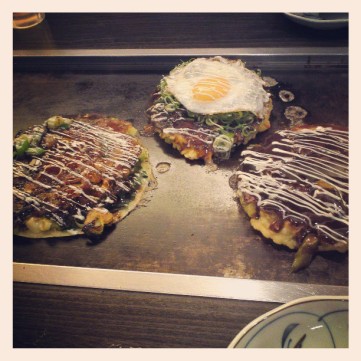 After Shitennouji, we headed back to the Namba area to check out a woodblock print museum, and then grabbed dinner before catching our train back to Mie. The past night, we had been too tired for an extravagant dinner, but on our last day, we decided to get a regional specialty,
After Shitennouji, we headed back to the Namba area to check out a woodblock print museum, and then grabbed dinner before catching our train back to Mie. The past night, we had been too tired for an extravagant dinner, but on our last day, we decided to get a regional specialty,
okonomiyaki! I had okonomiyaki once in Gunma with my coworkers, but since its origin is in the Kansai region, we had to try some here, too! It’s often described as “Japanese pizza”… but I don’t really understand why. It’s usually a cake-type item made of a batter of flour, some sort of potato, cabbage, and egg, as well as whatever meats and vegetables are desired. In the past, I haven’t liked it very much (it often contains ginger, which I really dislike), but I had to admit, these Kansai okonomiyaki were very delicious!
And with that, we headed back to Mie, full, tired, and happy. It was a great spring break, and I hope I can do more traveling with CT in the future!

Leave a comment